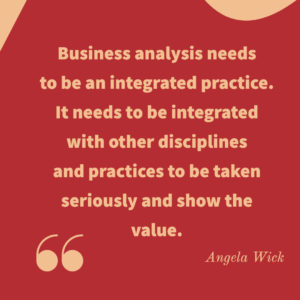
Everything BAs Do Involve Three Things
We all know how valuable business analysis is to organizations. As complex as our work is it all boils down to:
- Solving Problems
- Enabling Change
- Making Good Decisions
Problem-solving, change, and decisions are everyone’s business! Not just the BAs! Exactly! BAs help teams solve problems, enable change and make decisions. In many organizations, the role and title of the BA have been limited to a small system scope and writing requirements for project teams. Yet “business analysis” as a practice, set of skills and techniques goes so much deeper.
If we widen the lens and look at how organizations and teams identify, prioritize and solve problems; prepare for and provoke (or prevent) change, and make decisions (big and small) about the future state, we see the business analysis touches EVERYTHING! These critical pieces of every team and organization are all about people, workflows, processes, customer experience, systems, data, policies, vendors, partners… and most importantly, now they all connect and impact one another.
In the past, the BA role or title in many organizations tried to assume a context. For example, BAs work on preparing development teams for work to update a system and preparing the business/operations teams to accept the system changes. This is quite a narrow definition of what business analysis is as a whole and could stifle true results as organizations move more into integrated models of evolving, business models that enable agility, and digital models that put the focus on the customer experience.
Rethinking the BACoE
Organizations must look more broadly at how business analysis is done to enable the future of the organization. This means that a BA Center of Excellence, Community of Practice, BA Team, PMO, or whatever the organizational entity is that manages Business Analysis practices (and perhaps also the people performing this work) needs to be integrated within the organization as well.
In the past, many organizations have developed Centers of Excellence, Centers of Practice, and Communities for Business Analysis and BAs. These organizations had goals of making practices more consistent, building standards for BAs to follow, training, and building BA competencies/skills. These centers of excellence/practice/community have been primarily built on a traditional/waterfall IT systems context. Parts of this remain valid and other parts do not and these communities are struggling. They are struggling to show their value and struggling to find their way in an increasingly agile world where there isn’t a clear answer on how to transform the BA Practice into an Agile BA Practice.
If we are looking to build more agile BA practices and show the BA value, we need to rethink the purpose of a BA Center of Excellence/Practice/Community. We need to rethink the idea that business analysis is a phase or a stand-alone service. Business analysis needs to be an integrated practice. It needs to be integrated with other disciplines and practices to be taken seriously and show the value. The BA Center of Excellence/Practice/Community needs to be a collaborative force with the strategic transformations happening in the organization. Agile, Digital, Cloud, DevOps, Customer Experience, Process Engineering; the BA practice needs to integrate and align with these. We can no longer ask that these initiatives follow a BA process or practice we have set out and followed “our” requirements practice. We need to integrate business analysis into these processes and frameworks.
What Does An Integrated BA Practice Mean?
Integrating the analysis and requirements practices into these other frameworks is no easy task. It requires that we rethink what is a “standard” practice. It’s not about all projects following the same set of techniques and templates for requirements. What this means:
- Having a mindset and an analysis approach that is flexible to the needs of each team and project.
- Developing an approach using a toolbox of techniques and skilling the BA team to be empowered to choose the right technique at the right time for the needed purpose.
- Ensuring BAs know what effective analysis looks like, and feels like as part of the team, rather than focus on them knowing a template, process, and set of artifacts.
- Developing a practice that enables a set of generally accepted techniques and approaches that align with Agile, Digital, Process, Data, DevOps, Cyber Security, Package/Cloud Software, Customer Experience, etc.
- The BA Practice Leader/Manager spends much of the time connecting with and collaborating with other discipline leaders to align practices rather than talking other teams into accepting a defined BA practice.
- This likely means retooling, re-skilling, and reinventing what skills your BAs need, have, and work on improving.
Steps To Take Now
- Start meeting with other discipline leaders (Agile, QA, DevOps, Digital, CX, Process, etc..) ask them what their pain points are, and link to how analysis practices can help them be better at what they do. Learn and understand their practices and processes and where requirements and analysis to weave into them. Try to avoid the temptation to talk them into following your ideal BA practice. It’s not about getting buy-in to “do requirements right”, it is about getting traction on using analysis skills and practices in an integrated fashion throughout the organization to elevate business outcomes.
- Work with other discipline leaders on some experiments to see how BAs can partner with them to make them better at what they do.
Yes, that’s right! How can BAs make these other groups better at what they do? This is the million-dollar question that will drive value for the BA role and make the BA Practice an integrated practice.
We are here to help you along in this journey. Are you ready to integrate your practice and start building value for the BA Role in your organization? Here are two things you can do right now:

